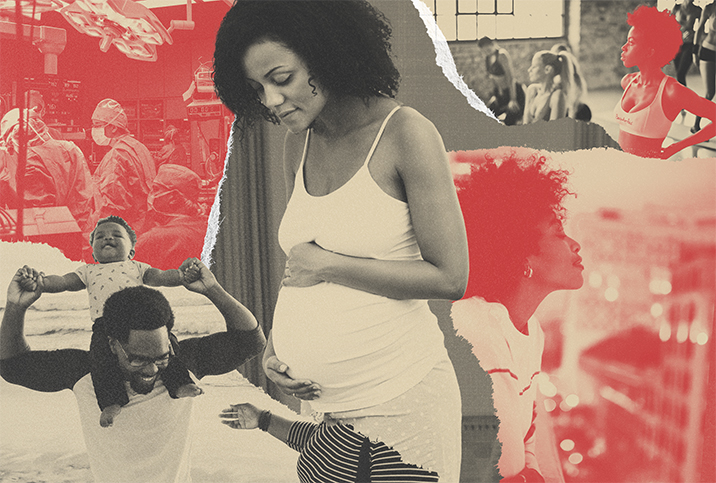Investing in Maternal Health Improves the Economy

"A healthy economy requires healthy mothers and healthy babies," remarked Vice President Kamala Harris in a recent statement at the Maternal Day of Action Summit.
The Institute for Women's Policy Research reports that more than 50 percent of mothers are the breadwinners for their families, and 74 percent of Black women are breadwinners for their households.
Vice President Harris affirmed this statistic and remarked, "Mothers are the backbone of our economy." However, the economy is failing to support maternal health.
In the United States, women are more likely to die of pregnancy-related complications than in any other high-income country.
According to the Centers for Disease Control and Prevention (CDC), 3 in 5 pregnancy-related deaths could be prevented. Further, Black women are two to four times more likely to die during or after childbirth than white women.
A recent white paper by the Federal Reserve Bank of New York highlights current findings and proposed solutions to address the maternal health crisis in America. The paper notes, "The cost of severe maternal morbidity is more of a financial burden to the system than the investments required to avoid the issue in the first place."
Investing in maternal health positively impacts the economy, but it will take policy change and shifts in businesses, down to details like employers offering a living wage and providing paid family leave.
How the cost of maternal morbidity impacts the economy
"The cost of a lost or seriously injured mother is pervasive," said Mimi Niles, Ph.D., M.P.H., an assistant professor/faculty fellow, NYU Rory Meyers College of Nursing, and one of the authors of the white paper.
These costs include medical, nonmedical, indirect and follow-up costs. The white paper notes that severe maternal morbidity increases delivery costs by about three times compared to a less complicated birth—and that the cost of the lifesaving measures needed in cases of severe maternal morbidity is a higher financial burden than the investments required to address the issue in the first place.
Raven Freeborn, senior advocacy and policy manager at Mamatoto Village, an organization mentioned in the white paper that provides perinatal support services, said medical costs can include repeat utilization of emergency care, extended hospital stays due to the onset of maternal morbidities, or short-term, acute or chronic symptoms.
"Nonmedical costs can include enrollment in social safety net benefits and maternal mental health diagnosis and treatment," Freeborn said.
'The cost of severe maternal morbidity is more of a financial burden to the system than the investments required to avoid the issue in the first place.'
Social safety net benefits may include "Supplemental Nutrition Assistance Program (SNAP), Special Supplemental Nutrition Program for Women, Infants, and Children (WIC), Medicaid, and Temporary Assistance for Needy Families (TANF)," Niles added.
Indirect costs equate to lost work and income, and can burden family housing or cause food insecurity.
"Although we know that current reports on spending related to maternal and child health care do not provide accurate depictions, we can see that the weight of the financial burden is spread across systems and consequently balanced on the back of birthing people and their families," Freeborn said.
Commonwealth Fund reports that the cost of maternal morbidity is greater than $32.3 billion between conception and age 5 of a child.
"As we see the rates of maternal morbidity increase, we will continue to see the medical and nonmedical costs grow," said Britta Cedergren, M.P.H., director of Family and Child Health of ASTHO, another organization mentioned in the white paper.
How employers can invest in maternal health
There are numerous ways employers can support maternal health, from providing a living wage to paid family leave for at least 12 weeks, said Audrey Lyndon, Ph.D., assistant dean for Clinical Research and the Vernice D. Ferguson Professor in Health Equity, NYU Rory Meyers College of Nursing, and an author of the white paper.
"Every organization and its leadership has an opportunity to engage in advocacy and education around the expansion of state-sponsored employer benefits for paid family leave," Freeborn said.
Lyndon suggested the following ways employers can support parents and families:
- Paid leave helps support breastfeeding, which promotes the health of mothers and infants and prevents illness. Employers can support breastfeeding with policy, break times and proper facilities.
- Employers can "provide no-copay coverage for contraception so people can determine whether and when they want to bear children, and can optimally space childbearing if multiple children are desired."
- Employers can also provide safe, high-quality onsite childcare and preventive medical and social services for larger companies. Smaller businesses can provide paid time off for appointments.
During the COVID-19 pandemic, 1 in 10 mothers quit their jobs. The research notes that a critical barrier for working mothers was access to childcare. Women, more specifically women of color, took on more childcare responsibilities, which unveiled disproportionate economic effects from the pandemic. A study shows that when childcare responsibilities arise, women reduce their work hours, not men.
The research asserts that when childcare subsidies are increased, employment among mothers increases. Unsurprisingly, when investments are made in maternal health, worker productivity increases.
"In the long term, healthier employees and families reduce employer insurance costs," Lyndon concluded.
Proposed policies and changes
One proposed policy in the white paper is the Build Back Better Act, which would largely advance birth equity. The Build Back Better Act extends Medicaid postpartum benefits from 60 days to 1 year, which is pertinent because more than half of pregnancy-related deaths happen up to a year post-birth. The act is unlikely to pass in its current form, but negotiations are ongoing.
Two other policies mentioned in the white paper are the housing first model (which helps families secure housing), and the second is baby bonds to narrow the racial wealth gap. Connecticut recently adopted this program to help address financial disparities.
Investing in home-visiting nurse programs can also help new mothers receive breastfeeding support and comprehensive postpartum support—these programs create better long-term health.
"We also need broad and deep investment in models of care that are outside of the hospital—midwifery birth centers are an optimum way of bringing health back into the communities," Niles said. "Midwife-led birth centers offer person-centered care that supports a person's autonomy and their cultural beliefs, while promoting healthcare decision-making and respectful care that hospitals really struggle to provide."
"We need to normalize birth," Niles continued. "It has become 'clinical' as a way to maintain power within the hospital system, and that needs to change."
Investing in maternal care and systemic disparities
Systemic inequities account for why Black and Indigenous women die at higher rates than white women before, during and after birth. Cedergren said that even traditional protective factors, such as higher income or education, do not seem to mitigate the maternal mortality rates and morbidity faced by BIPOC pregnant people.
American Progress makes the following recommendations for eliminating racial disparities in maternal care:
- Improving access to critical services
- Improving quality of care
- Addressing maternal mental health
- Increasing support for families before and after birth
- Improving data collection
Freeborn explained that one of many nonmedical morbidities experienced by birthing people and their families is the onset of mental health disorders within the postpartum period and the progression of preexisting mental health conditions during and after pregnancy.
"This and other maternal morbidities may influence parent/child attachment, infant and early child social-emotional development, and workforce participation and advancement," Freeborn said.
ASTHO advocates for prioritizing services for marginalized women of reproductive age and "also recommends increased reimbursement by Medicaid and private insurance for the use of evidence-based screening tools to detect potential contributing factors to morbidity, such as perinatal mood and anxiety disorders, substance misuse, and disorders of pregnancy and chronic disease," Cedergren said.
Maternal health and economic futures
Maternal death rates in the U.S. are a public health crisis—death rates have doubled over the past few decades. If mothers are the backbone of the economy, as Vice President Harris asserts, it's crucial to invest in maternal health for health and economic outcomes.
"The root of the word 'economy' comes from Greek, meaning to 'manage the household,'" Niles said. "We need to reframe what a healthy economy is.
"We have to stop thinking about maternal care just involving pregnancy and birth," Niles continued. "Maternal means mother—caring and investing in mothers will both, directly and indirectly, create equity. Equitable access to education, to childcare, to employment, to green spaces, to the arts—all these may seem unrelated to maternal health, but a healthy mom is at the root of [a] healthy family, and a healthy family is a building block of [a] healthy community."


















